Statistics Case Study Analysis for Business Decisions
VerifiedAdded on 2021/06/15
|26
|2335
|106
Case Study
AI Summary
This case study analyzes various statistical models and their applications in business decision-making, hotel management, and profit maximization. The assignment covers decision-making processes using different criteria, including optimistic, pessimistic, Laplace, and EMV, to determine optimal strategies for a fish vendor. It also explores the impact of perfect and imperfect information on decision outcomes. Furthermore, the case study delves into hotel management scenarios, analyzing daily costs, overbooking strategies, and the use of Excel for simulations. Regression models are applied to analyze the relationship between car prices, mileage, and age, while correlation analysis examines the relationship between mileage and age. Finally, the assignment uses Excel Solver to determine optimal production levels for profit maximization, considering different products and scenarios.
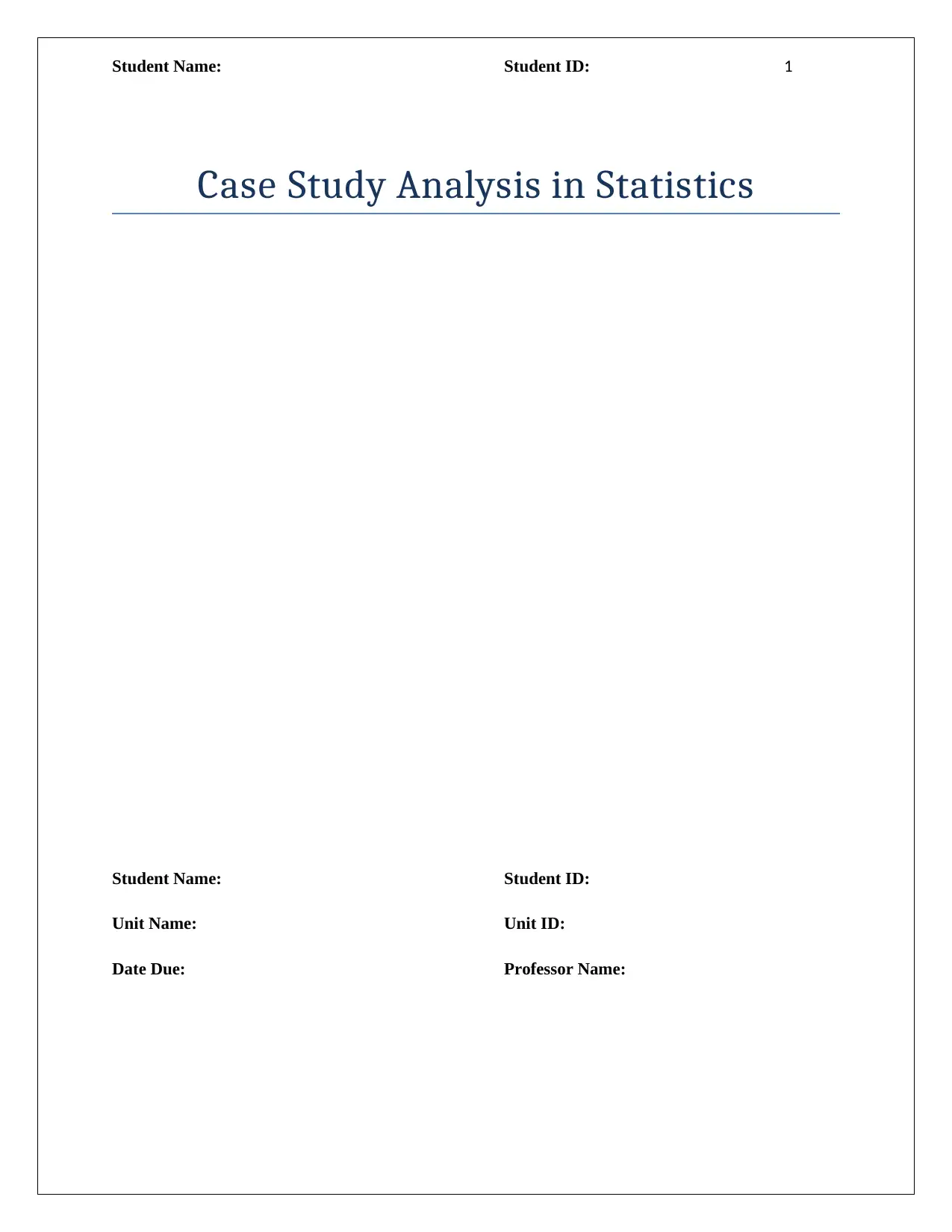
Student Name: Student ID: 1
Case Study Analysis in Statistics
Student Name: Student ID:
Unit Name: Unit ID:
Date Due: Professor Name:
Case Study Analysis in Statistics
Student Name: Student ID:
Unit Name: Unit ID:
Date Due: Professor Name:
Paraphrase This Document
Need a fresh take? Get an instant paraphrase of this document with our AI Paraphraser
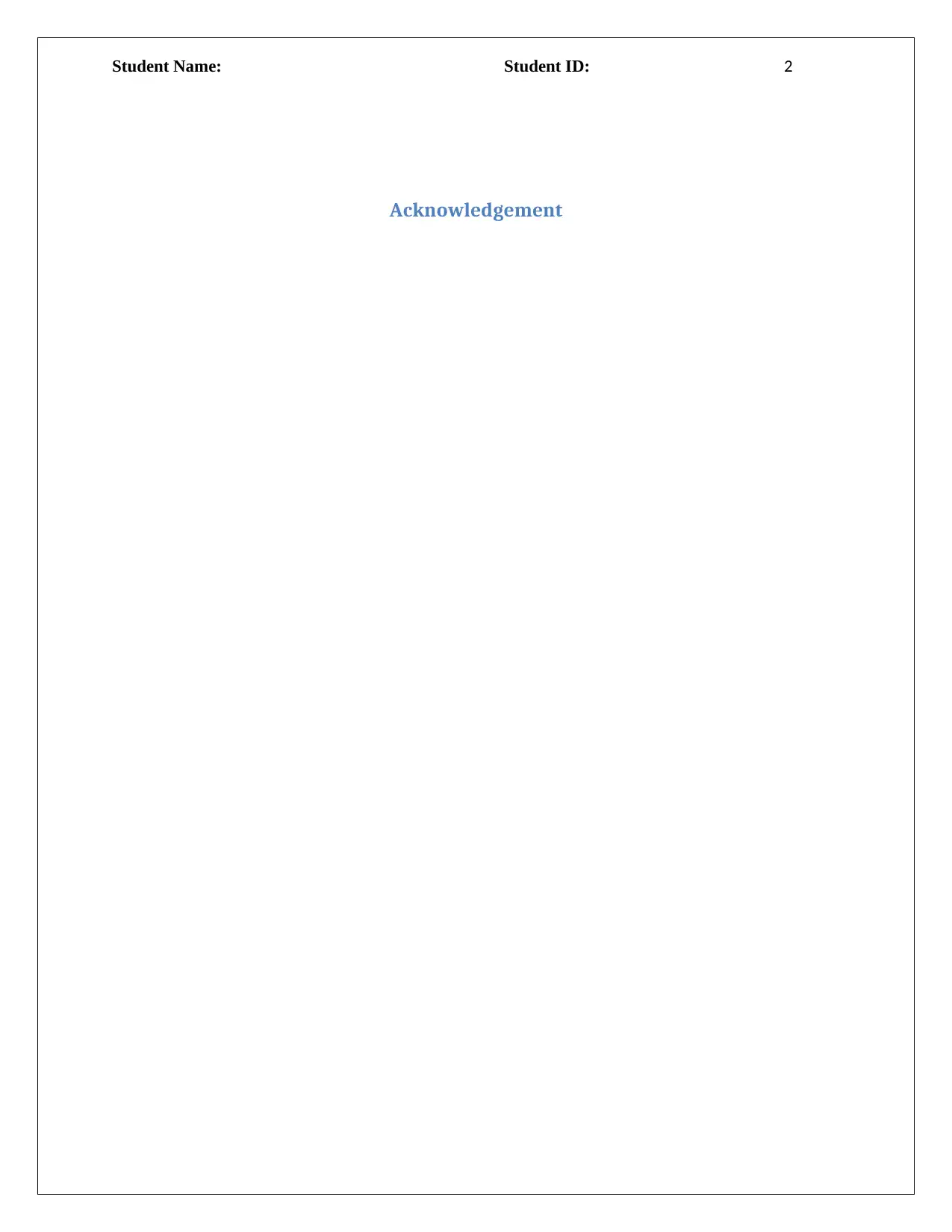
Student Name: Student ID: 2
Acknowledgement
Acknowledgement
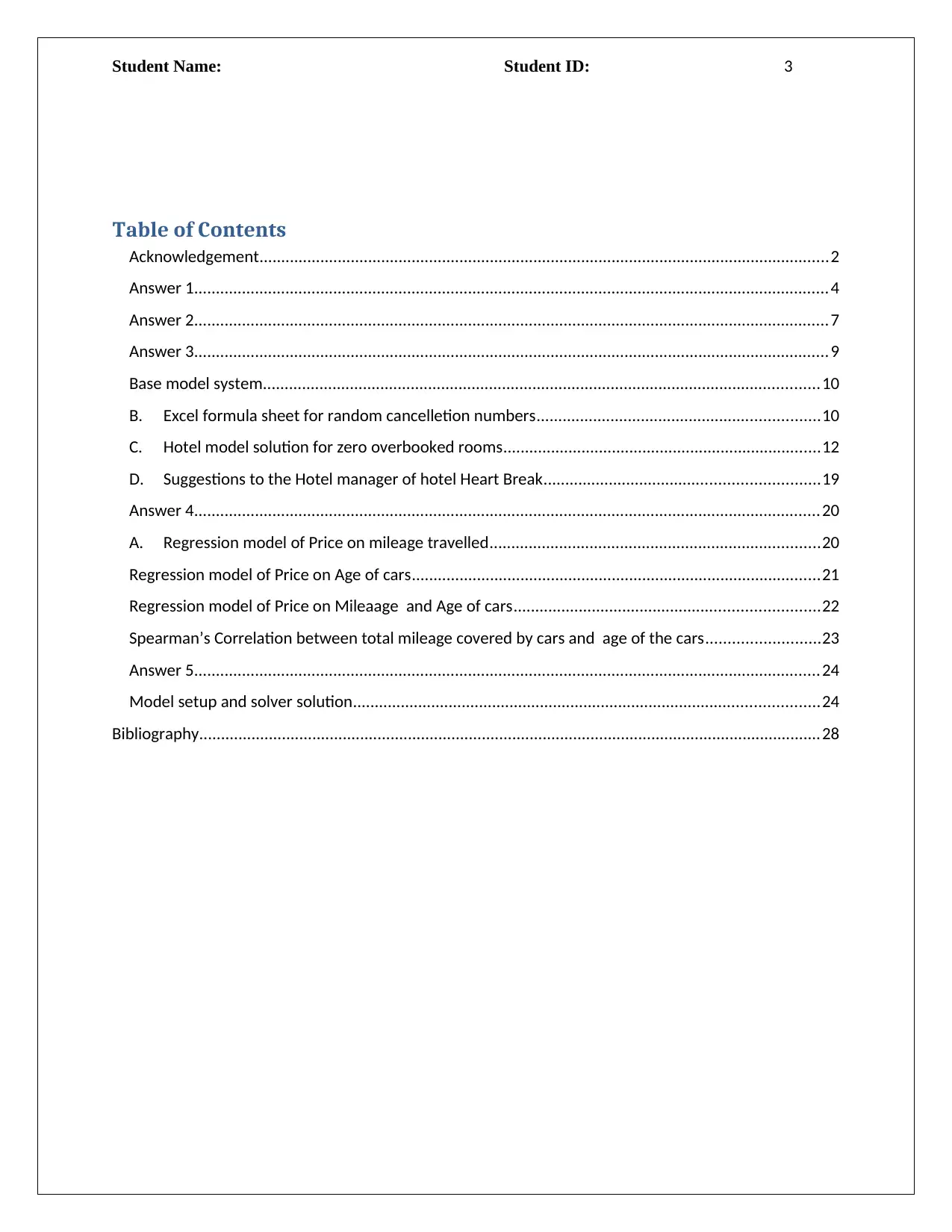
Student Name: Student ID: 3
Table of Contents
Acknowledgement...................................................................................................................................2
Answer 1..................................................................................................................................................4
Answer 2..................................................................................................................................................7
Answer 3..................................................................................................................................................9
Base model system................................................................................................................................10
B. Excel formula sheet for random cancelletion numbers.................................................................10
C. Hotel model solution for zero overbooked rooms.........................................................................12
D. Suggestions to the Hotel manager of hotel Heart Break...............................................................19
Answer 4................................................................................................................................................20
A. Regression model of Price on mileage travelled............................................................................20
Regression model of Price on Age of cars..............................................................................................21
Regression model of Price on Mileaage and Age of cars......................................................................22
Spearman’s Correlation between total mileage covered by cars and age of the cars..........................23
Answer 5................................................................................................................................................24
Model setup and solver solution...........................................................................................................24
Bibliography...............................................................................................................................................28
Table of Contents
Acknowledgement...................................................................................................................................2
Answer 1..................................................................................................................................................4
Answer 2..................................................................................................................................................7
Answer 3..................................................................................................................................................9
Base model system................................................................................................................................10
B. Excel formula sheet for random cancelletion numbers.................................................................10
C. Hotel model solution for zero overbooked rooms.........................................................................12
D. Suggestions to the Hotel manager of hotel Heart Break...............................................................19
Answer 4................................................................................................................................................20
A. Regression model of Price on mileage travelled............................................................................20
Regression model of Price on Age of cars..............................................................................................21
Regression model of Price on Mileaage and Age of cars......................................................................22
Spearman’s Correlation between total mileage covered by cars and age of the cars..........................23
Answer 5................................................................................................................................................24
Model setup and solver solution...........................................................................................................24
Bibliography...............................................................................................................................................28
⊘ This is a preview!⊘
Do you want full access?
Subscribe today to unlock all pages.

Trusted by 1+ million students worldwide
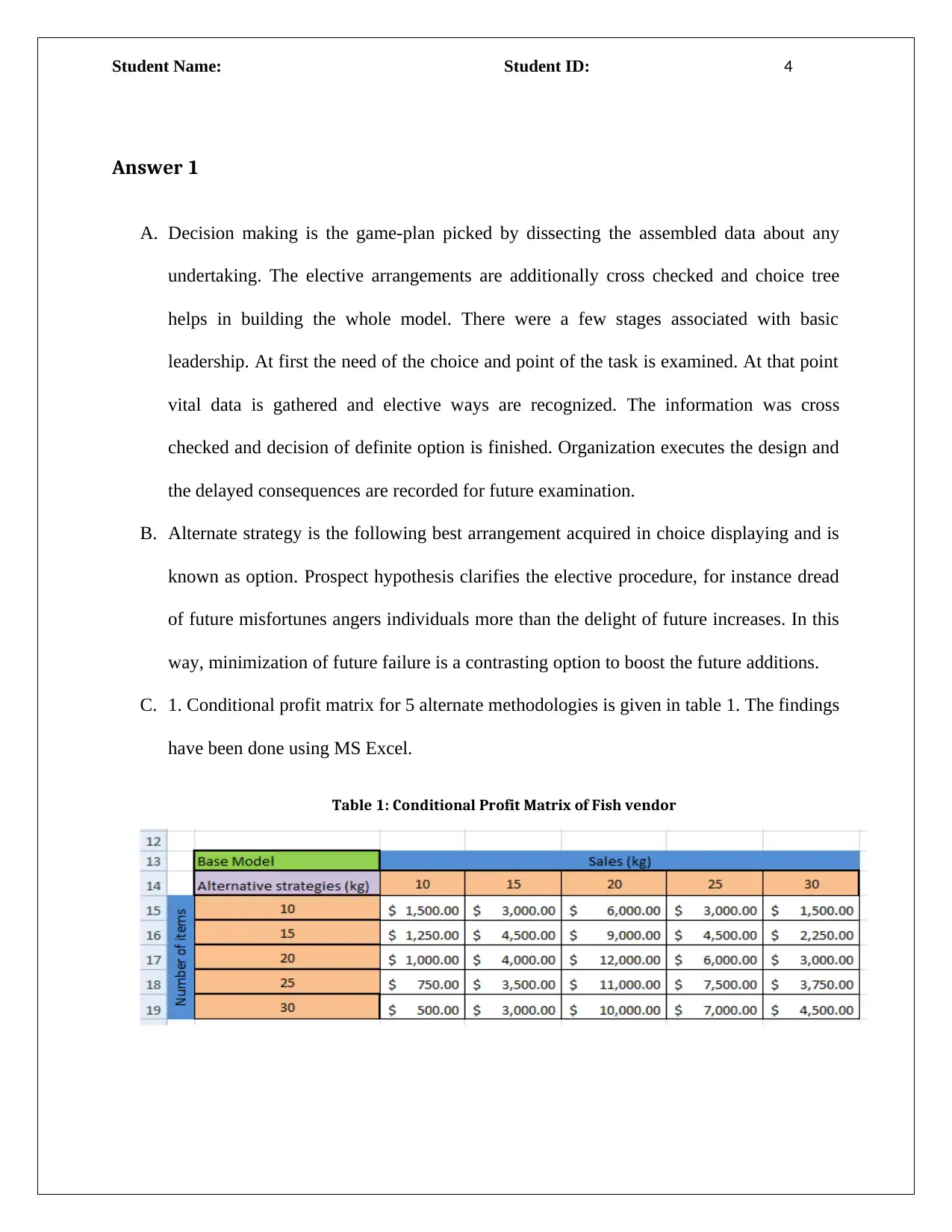
Student Name: Student ID: 4
Answer 1
A. Decision making is the game-plan picked by dissecting the assembled data about any
undertaking. The elective arrangements are additionally cross checked and choice tree
helps in building the whole model. There were a few stages associated with basic
leadership. At first the need of the choice and point of the task is examined. At that point
vital data is gathered and elective ways are recognized. The information was cross
checked and decision of definite option is finished. Organization executes the design and
the delayed consequences are recorded for future examination.
B. Alternate strategy is the following best arrangement acquired in choice displaying and is
known as option. Prospect hypothesis clarifies the elective procedure, for instance dread
of future misfortunes angers individuals more than the delight of future increases. In this
way, minimization of future failure is a contrasting option to boost the future additions.
C. 1. Conditional profit matrix for 5 alternate methodologies is given in table 1. The findings
have been done using MS Excel.
Table 1: Conditional Profit Matrix of Fish vendor
Answer 1
A. Decision making is the game-plan picked by dissecting the assembled data about any
undertaking. The elective arrangements are additionally cross checked and choice tree
helps in building the whole model. There were a few stages associated with basic
leadership. At first the need of the choice and point of the task is examined. At that point
vital data is gathered and elective ways are recognized. The information was cross
checked and decision of definite option is finished. Organization executes the design and
the delayed consequences are recorded for future examination.
B. Alternate strategy is the following best arrangement acquired in choice displaying and is
known as option. Prospect hypothesis clarifies the elective procedure, for instance dread
of future misfortunes angers individuals more than the delight of future increases. In this
way, minimization of future failure is a contrasting option to boost the future additions.
C. 1. Conditional profit matrix for 5 alternate methodologies is given in table 1. The findings
have been done using MS Excel.
Table 1: Conditional Profit Matrix of Fish vendor
Paraphrase This Document
Need a fresh take? Get an instant paraphrase of this document with our AI Paraphraser
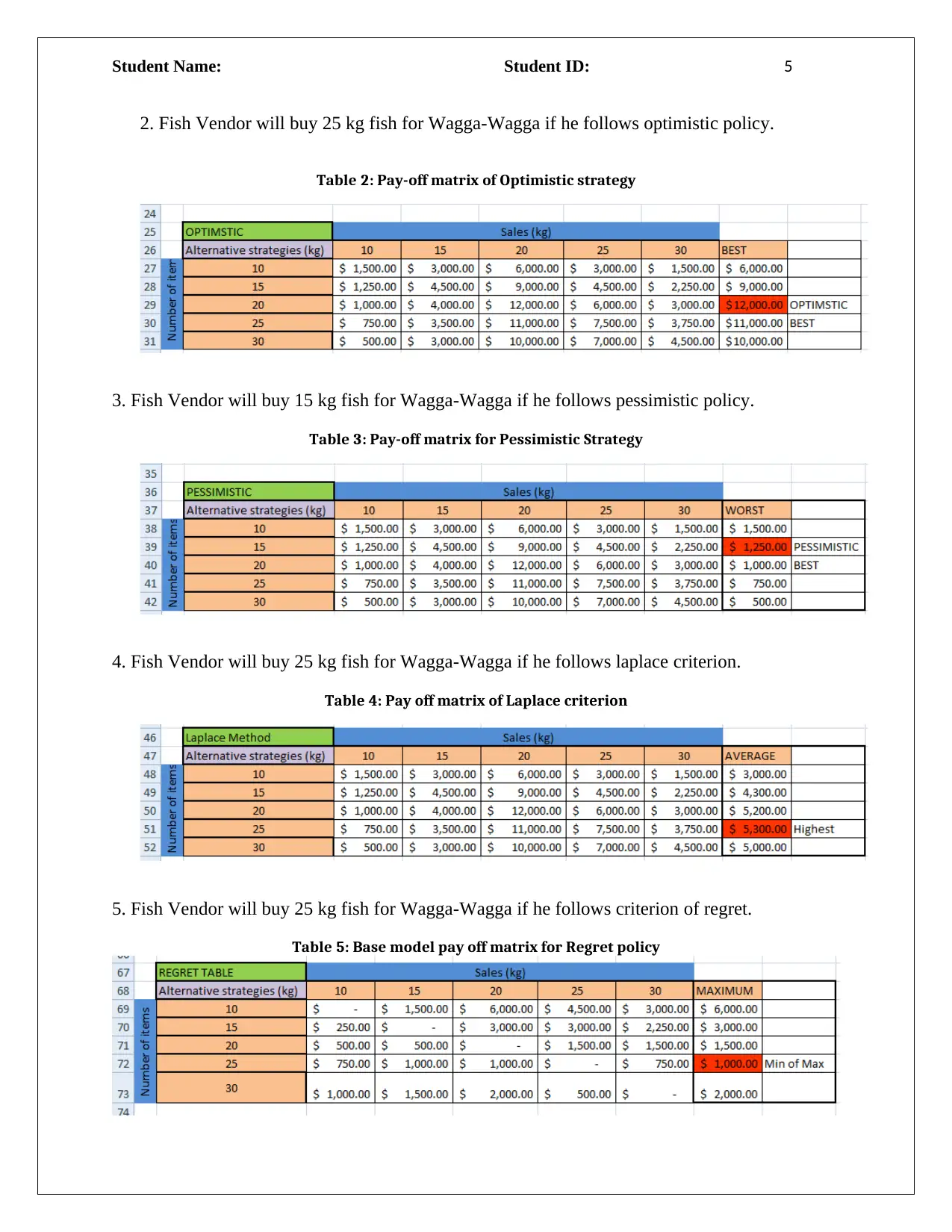
Student Name: Student ID: 5
2. Fish Vendor will buy 25 kg fish for Wagga-Wagga if he follows optimistic policy.
Table 2: Pay-off matrix of Optimistic strategy
3. Fish Vendor will buy 15 kg fish for Wagga-Wagga if he follows pessimistic policy.
Table 3: Pay-off matrix for Pessimistic Strategy
4. Fish Vendor will buy 25 kg fish for Wagga-Wagga if he follows laplace criterion.
Table 4: Pay off matrix of Laplace criterion
5. Fish Vendor will buy 25 kg fish for Wagga-Wagga if he follows criterion of regret.
Table 5: Base model pay off matrix for Regret policy
2. Fish Vendor will buy 25 kg fish for Wagga-Wagga if he follows optimistic policy.
Table 2: Pay-off matrix of Optimistic strategy
3. Fish Vendor will buy 15 kg fish for Wagga-Wagga if he follows pessimistic policy.
Table 3: Pay-off matrix for Pessimistic Strategy
4. Fish Vendor will buy 25 kg fish for Wagga-Wagga if he follows laplace criterion.
Table 4: Pay off matrix of Laplace criterion
5. Fish Vendor will buy 25 kg fish for Wagga-Wagga if he follows criterion of regret.
Table 5: Base model pay off matrix for Regret policy
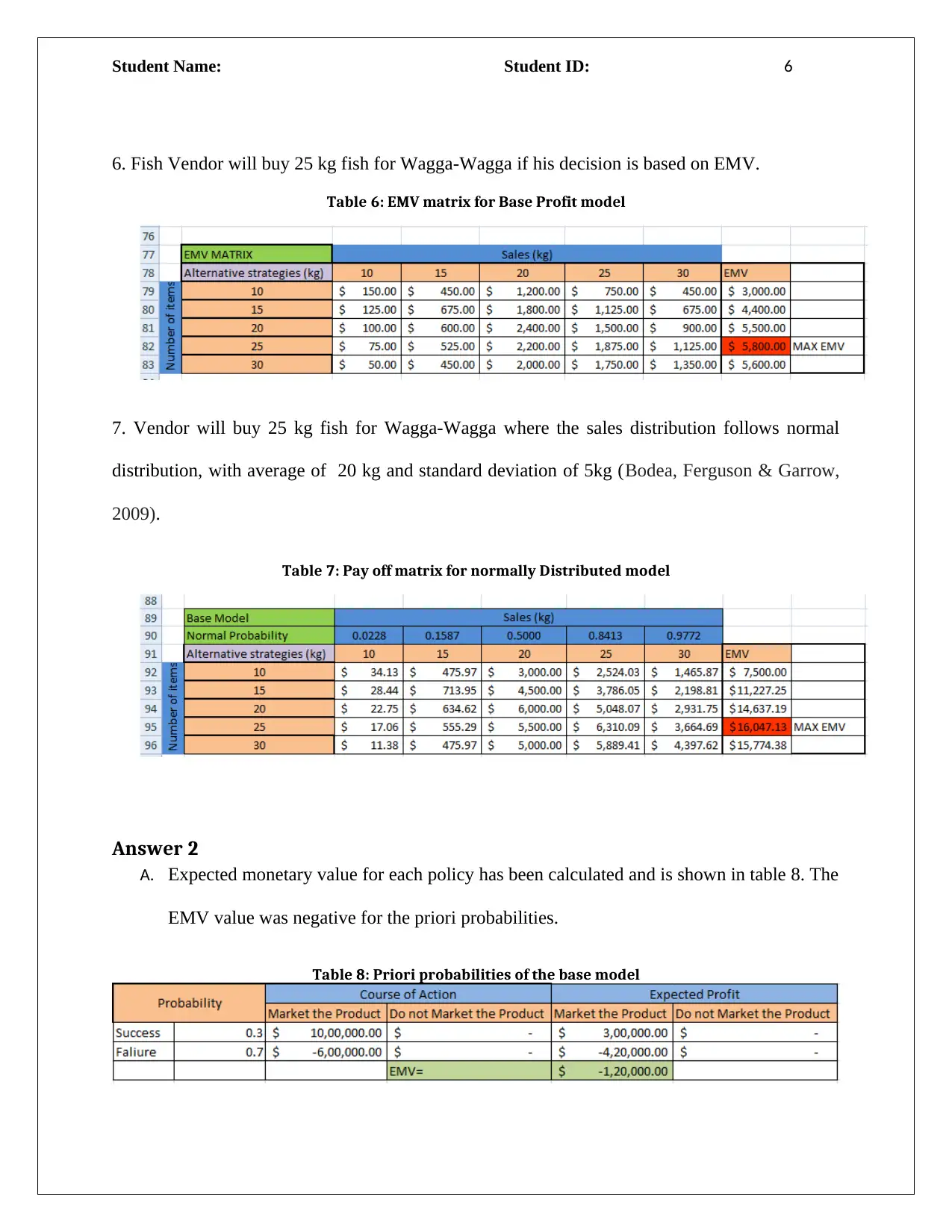
Student Name: Student ID: 6
6. Fish Vendor will buy 25 kg fish for Wagga-Wagga if his decision is based on EMV.
Table 6: EMV matrix for Base Profit model
7. Vendor will buy 25 kg fish for Wagga-Wagga where the sales distribution follows normal
distribution, with average of 20 kg and standard deviation of 5kg (Bodea, Ferguson & Garrow,
2009).
Table 7: Pay off matrix for normally Distributed model
Answer 2
A. Expected monetary value for each policy has been calculated and is shown in table 8. The
EMV value was negative for the priori probabilities.
Table 8: Priori probabilities of the base model
6. Fish Vendor will buy 25 kg fish for Wagga-Wagga if his decision is based on EMV.
Table 6: EMV matrix for Base Profit model
7. Vendor will buy 25 kg fish for Wagga-Wagga where the sales distribution follows normal
distribution, with average of 20 kg and standard deviation of 5kg (Bodea, Ferguson & Garrow,
2009).
Table 7: Pay off matrix for normally Distributed model
Answer 2
A. Expected monetary value for each policy has been calculated and is shown in table 8. The
EMV value was negative for the priori probabilities.
Table 8: Priori probabilities of the base model
⊘ This is a preview!⊘
Do you want full access?
Subscribe today to unlock all pages.

Trusted by 1+ million students worldwide
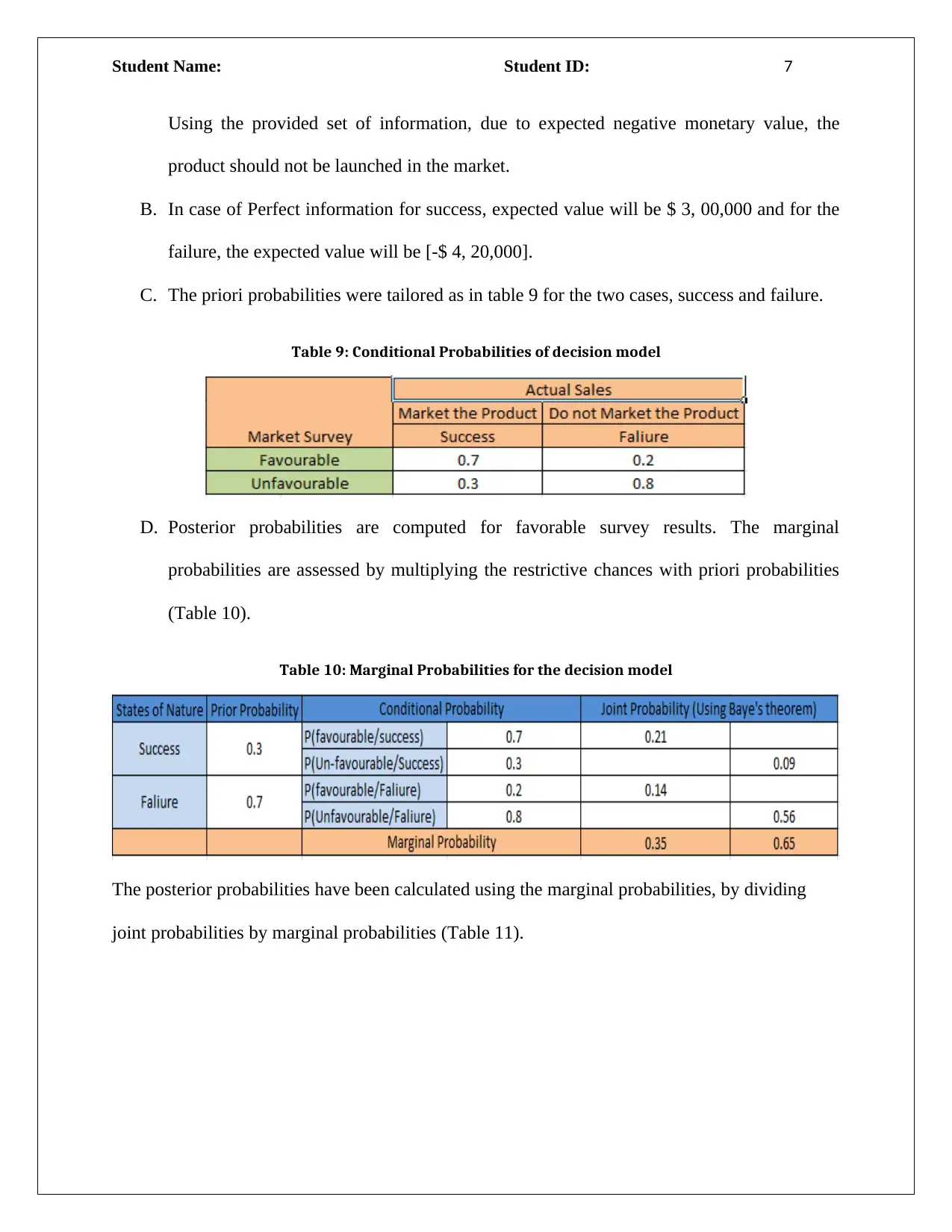
Student Name: Student ID: 7
Using the provided set of information, due to expected negative monetary value, the
product should not be launched in the market.
B. In case of Perfect information for success, expected value will be $ 3, 00,000 and for the
failure, the expected value will be [-$ 4, 20,000].
C. The priori probabilities were tailored as in table 9 for the two cases, success and failure.
Table 9: Conditional Probabilities of decision model
D. Posterior probabilities are computed for favorable survey results. The marginal
probabilities are assessed by multiplying the restrictive chances with priori probabilities
(Table 10).
Table 10: Marginal Probabilities for the decision model
The posterior probabilities have been calculated using the marginal probabilities, by dividing
joint probabilities by marginal probabilities (Table 11).
Using the provided set of information, due to expected negative monetary value, the
product should not be launched in the market.
B. In case of Perfect information for success, expected value will be $ 3, 00,000 and for the
failure, the expected value will be [-$ 4, 20,000].
C. The priori probabilities were tailored as in table 9 for the two cases, success and failure.
Table 9: Conditional Probabilities of decision model
D. Posterior probabilities are computed for favorable survey results. The marginal
probabilities are assessed by multiplying the restrictive chances with priori probabilities
(Table 10).
Table 10: Marginal Probabilities for the decision model
The posterior probabilities have been calculated using the marginal probabilities, by dividing
joint probabilities by marginal probabilities (Table 11).
Paraphrase This Document
Need a fresh take? Get an instant paraphrase of this document with our AI Paraphraser
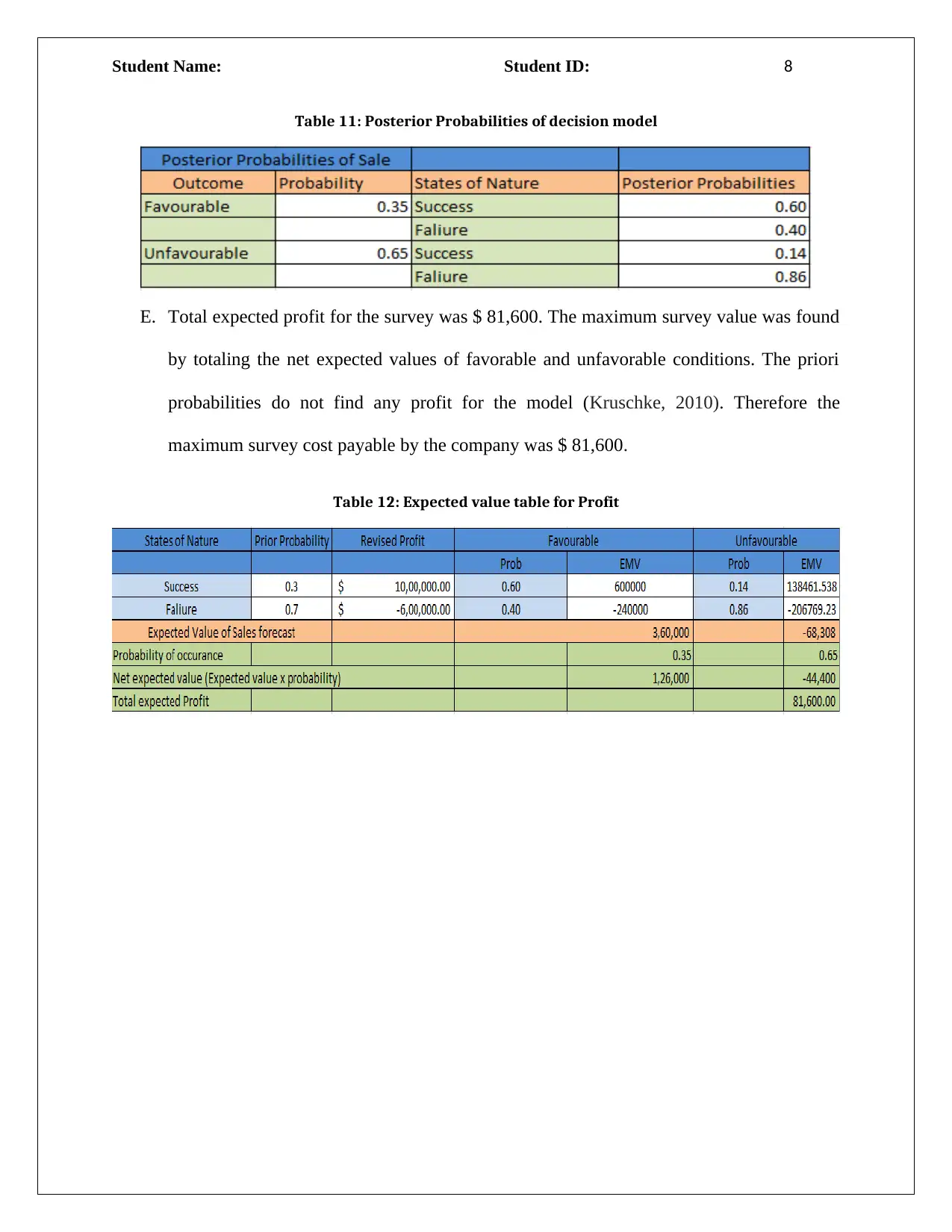
Student Name: Student ID: 8
Table 11: Posterior Probabilities of decision model
E. Total expected profit for the survey was $ 81,600. The maximum survey value was found
by totaling the net expected values of favorable and unfavorable conditions. The priori
probabilities do not find any profit for the model (Kruschke, 2010). Therefore the
maximum survey cost payable by the company was $ 81,600.
Table 12: Expected value table for Profit
Table 11: Posterior Probabilities of decision model
E. Total expected profit for the survey was $ 81,600. The maximum survey value was found
by totaling the net expected values of favorable and unfavorable conditions. The priori
probabilities do not find any profit for the model (Kruschke, 2010). Therefore the
maximum survey cost payable by the company was $ 81,600.
Table 12: Expected value table for Profit
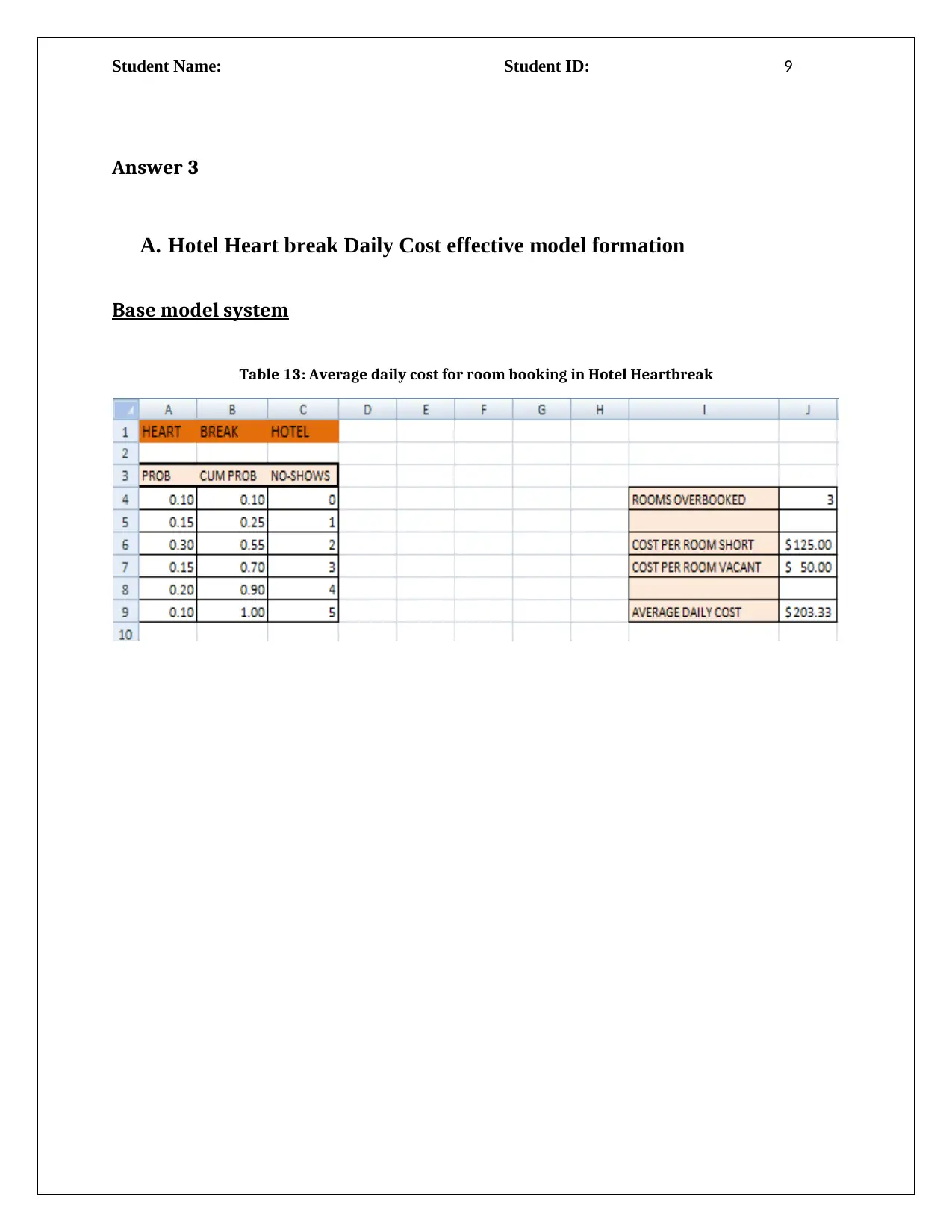
Student Name: Student ID: 9
Answer 3
A. Hotel Heart break Daily Cost effective model formation
Base model system
Table 13: Average daily cost for room booking in Hotel Heartbreak
Answer 3
A. Hotel Heart break Daily Cost effective model formation
Base model system
Table 13: Average daily cost for room booking in Hotel Heartbreak
⊘ This is a preview!⊘
Do you want full access?
Subscribe today to unlock all pages.

Trusted by 1+ million students worldwide
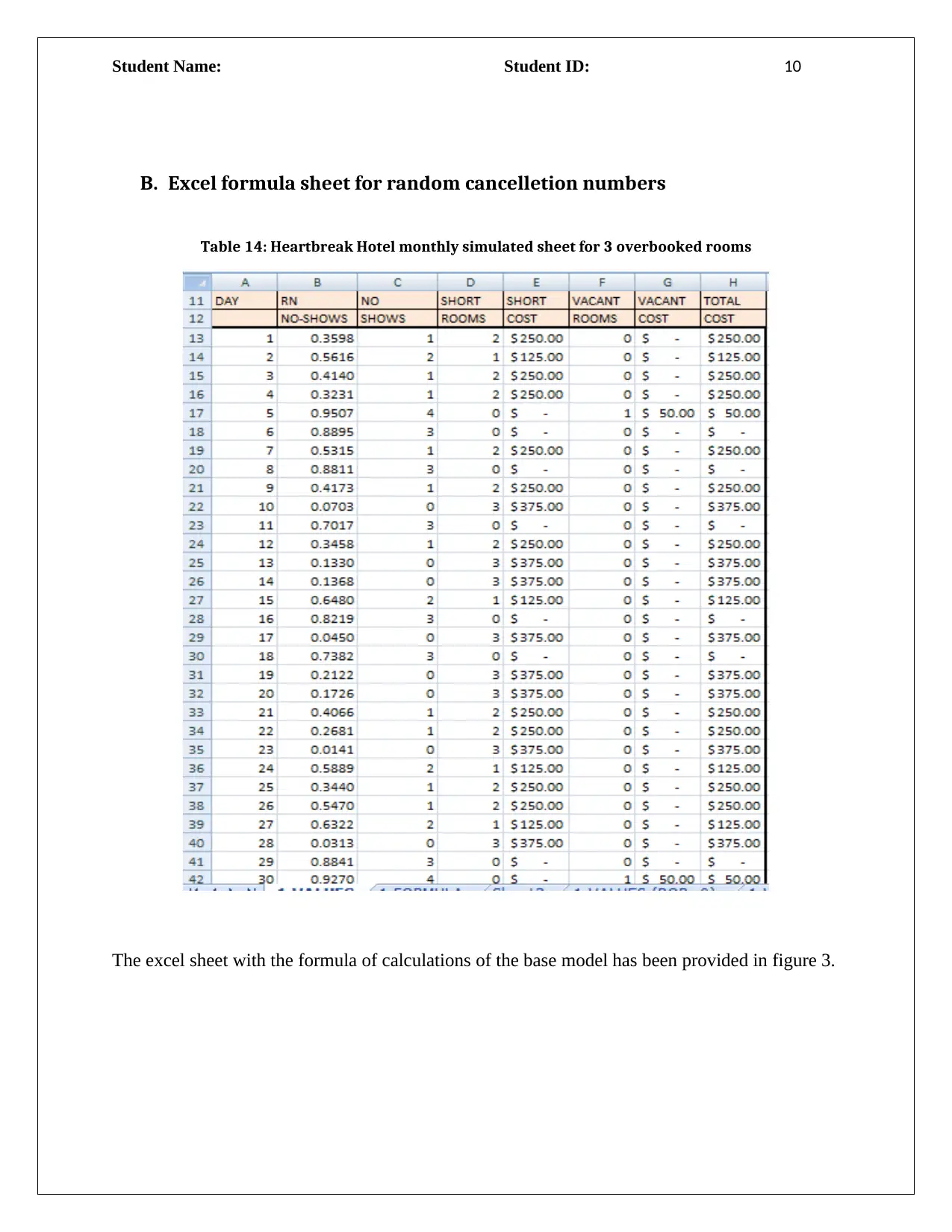
Student Name: Student ID: 10
B. Excel formula sheet for random cancelletion numbers
Table 14: Heartbreak Hotel monthly simulated sheet for 3 overbooked rooms
The excel sheet with the formula of calculations of the base model has been provided in figure 3.
B. Excel formula sheet for random cancelletion numbers
Table 14: Heartbreak Hotel monthly simulated sheet for 3 overbooked rooms
The excel sheet with the formula of calculations of the base model has been provided in figure 3.
Paraphrase This Document
Need a fresh take? Get an instant paraphrase of this document with our AI Paraphraser
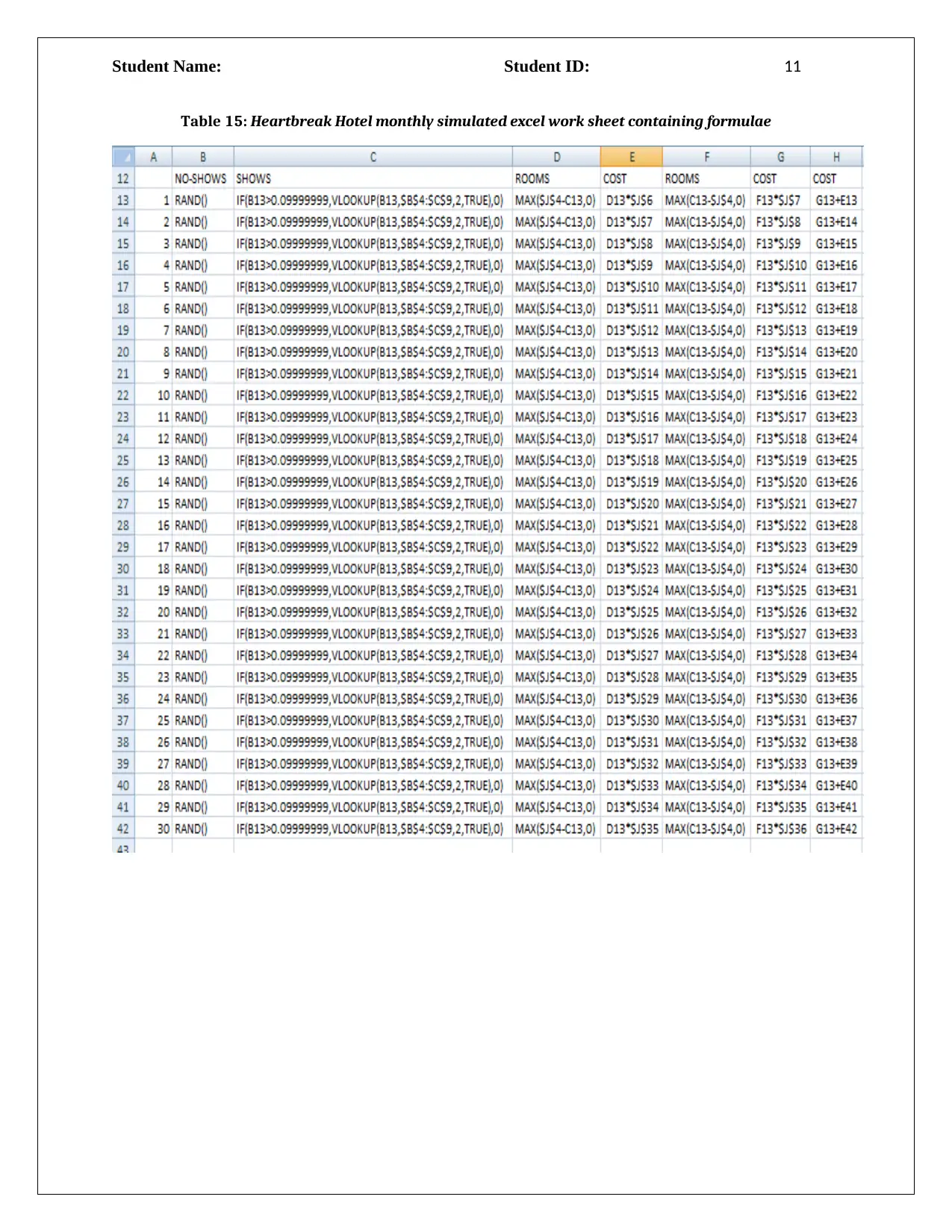
Student Name: Student ID: 11
Table 15: Heartbreak Hotel monthly simulated excel work sheet containing formulae
Table 15: Heartbreak Hotel monthly simulated excel work sheet containing formulae
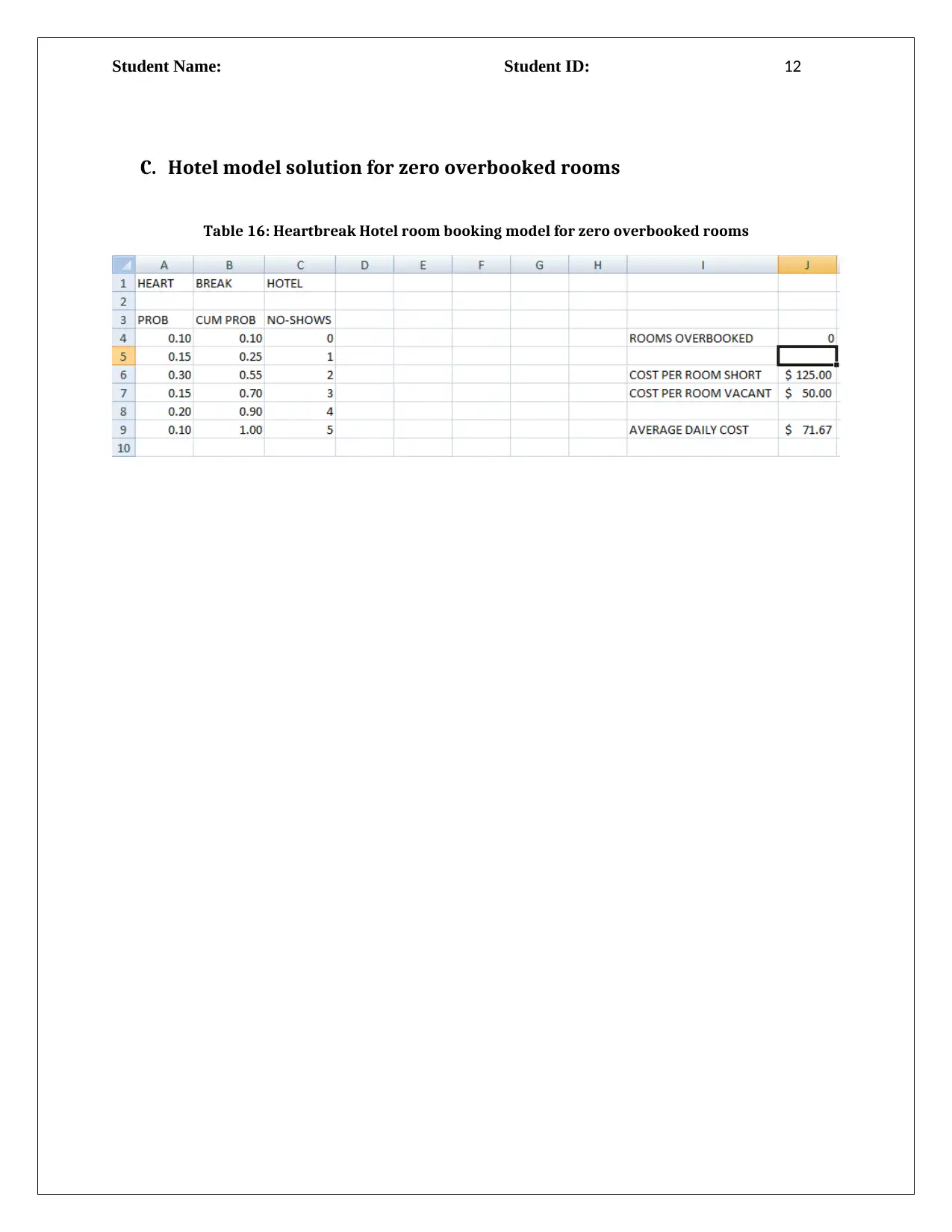
Student Name: Student ID: 12
C. Hotel model solution for zero overbooked rooms
Table 16: Heartbreak Hotel room booking model for zero overbooked rooms
C. Hotel model solution for zero overbooked rooms
Table 16: Heartbreak Hotel room booking model for zero overbooked rooms
⊘ This is a preview!⊘
Do you want full access?
Subscribe today to unlock all pages.

Trusted by 1+ million students worldwide
1 out of 26
Related Documents
Your All-in-One AI-Powered Toolkit for Academic Success.
+13062052269
info@desklib.com
Available 24*7 on WhatsApp / Email
![[object Object]](/_next/static/media/star-bottom.7253800d.svg)
Unlock your academic potential
Copyright © 2020–2025 A2Z Services. All Rights Reserved. Developed and managed by ZUCOL.

![Assignment: Accounting Decision Support Tools - [Date] - Finance](/_next/image/?url=https%3A%2F%2Fdesklib.com%2Fmedia%2Fimages%2Fga%2F85e3fe63d61d4af3a506409b3f137201.jpg&w=256&q=75)

